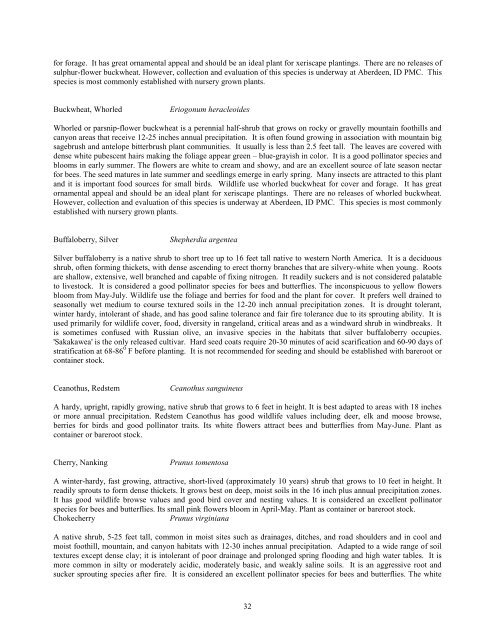Idaho Plant Materials Technical Note No. 24
Idaho Plant Materials Technical Note No. 24
Idaho Plant Materials Technical Note No. 24
You also want an ePaper? Increase the reach of your titles
YUMPU automatically turns print PDFs into web optimized ePapers that Google loves.
for forage. It has great ornamental appeal and should be an ideal plant for xeriscape plantings. There are no releases of<br />
sulphur-flower buckwheat. However, collection and evaluation of this species is underway at Aberdeen, ID PMC. This<br />
species is most commonly established with nursery grown plants.<br />
Buckwheat, Whorled<br />
Eriogonum heracleoides<br />
Whorled or parsnip-flower buckwheat is a perennial half-shrub that grows on rocky or gravelly mountain foothills and<br />
canyon areas that receive 12-25 inches annual precipitation. It is often found growing in association with mountain big<br />
sagebrush and antelope bitterbrush plant communities. It usually is less than 2.5 feet tall. The leaves are covered with<br />
dense white pubescent hairs making the foliage appear green – blue-grayish in color. It is a good pollinator species and<br />
blooms in early summer. The flowers are white to cream and showy, and are an excellent source of late season nectar<br />
for bees. The seed matures in late summer and seedlings emerge in early spring. Many insects are attracted to this plant<br />
and it is important food sources for small birds. Wildlife use whorled buckwheat for cover and forage. It has great<br />
ornamental appeal and should be an ideal plant for xeriscape plantings. There are no releases of whorled buckwheat.<br />
However, collection and evaluation of this species is underway at Aberdeen, ID PMC. This species is most commonly<br />
established with nursery grown plants.<br />
Buffaloberry, Silver<br />
Shepherdia argentea<br />
Silver buffaloberry is a native shrub to short tree up to 16 feet tall native to western <strong>No</strong>rth America. It is a deciduous<br />
shrub, often forming thickets, with dense ascending to erect thorny branches that are silvery-white when young. Roots<br />
are shallow, extensive, well branched and capable of fixing nitrogen. It readily suckers and is not considered palatable<br />
to livestock. It is considered a good pollinator species for bees and butterflies. The inconspicuous to yellow flowers<br />
bloom from May-July. Wildlife use the foliage and berries for food and the plant for cover. It prefers well drained to<br />
seasonally wet medium to course textured soils in the 12-20 inch annual precipitation zones. It is drought tolerant,<br />
winter hardy, intolerant of shade, and has good saline tolerance and fair fire tolerance due to its sprouting ability. It is<br />
used primarily for wildlife cover, food, diversity in rangeland, critical areas and as a windward shrub in windbreaks. It<br />
is sometimes confused with Russian olive, an invasive species in the habitats that silver buffaloberry occupies.<br />
'Sakakawea' is the only released cultivar. Hard seed coats require 20-30 minutes of acid scarification and 60-90 days of<br />
stratification at 68-86 0 F before planting. It is not recommended for seeding and should be established with bareroot or<br />
container stock.<br />
Ceanothus, Redstem<br />
Ceanothus sanguineus<br />
A hardy, upright, rapidly growing, native shrub that grows to 6 feet in height. It is best adapted to areas with 18 inches<br />
or more annual precipitation. Redstem Ceanothus has good wildlife values including deer, elk and moose browse,<br />
berries for birds and good pollinator traits. Its white flowers attract bees and butterflies from May-June. <strong>Plant</strong> as<br />
container or bareroot stock.<br />
Cherry, Nanking<br />
Prunus tomentosa<br />
A winter-hardy, fast growing, attractive, short-lived (approximately 10 years) shrub that grows to 10 feet in height. It<br />
readily sprouts to form dense thickets. It grows best on deep, moist soils in the 16 inch plus annual precipitation zones.<br />
It has good wildlife browse values and good bird cover and nesting values. It is considered an excellent pollinator<br />
species for bees and butterflies. Its small pink flowers bloom in April-May. <strong>Plant</strong> as container or bareroot stock.<br />
Chokecherry<br />
Prunus virginiana<br />
A native shrub, 5-25 feet tall, common in moist sites such as drainages, ditches, and road shoulders and in cool and<br />
moist foothill, mountain, and canyon habitats with 12-30 inches annual precipitation. Adapted to a wide range of soil<br />
textures except dense clay; it is intolerant of poor drainage and prolonged spring flooding and high water tables. It is<br />
more common in silty or moderately acidic, moderately basic, and weakly saline soils. It is an aggressive root and<br />
sucker sprouting species after fire. It is considered an excellent pollinator species for bees and butterflies. The white<br />
32
















